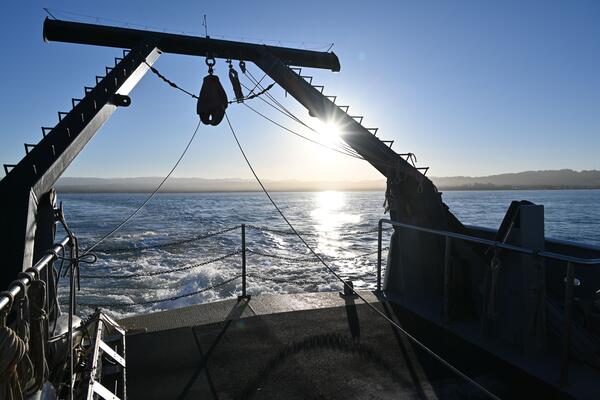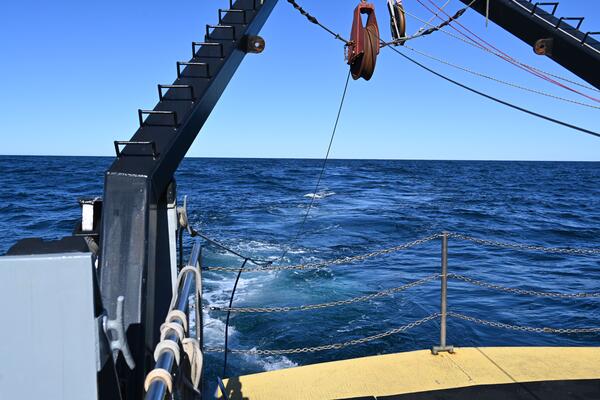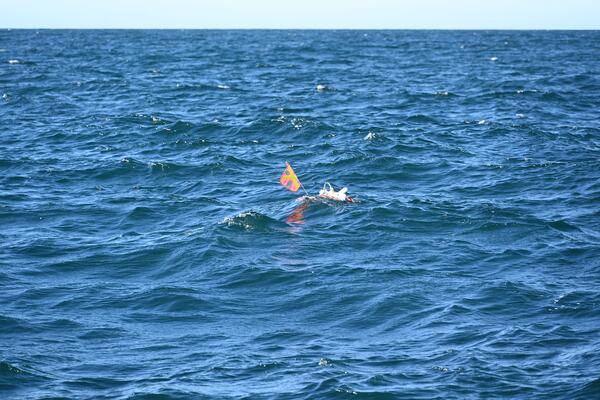A magnitude 7.0 earthquake ruptured the Mendocino Transform Fault offshore Northern California on December 5, 2024. The USGS and colleagues from the Woods Hole Oceanographic Institution’s Ocean Bottom Seismic Instrument Center deployed our new fleet of rapid response ocean bottom seismographs just 11 days later—the fastest response in U.S. history.
Nathaniel C Miller, PhD
Nathan Miller is a Research Geophysicist with the Earthquake Hazards Project at the Woods Hole Coastal and Marine Science Center.
Science and Products
Cascadia Subduction Zone Marine Geohazards
The Mid-Atlantic Resource Imaging Experiment (MATRIX)
High-resolution multichannel sparker seismic-reflection and chirp sub-bottom data acquired along the Cascadia margin during USGS field activity 2019-024-FA
High-resolution multichannel seismic reflection data collected along the New England outer continental shelf, slope, and rise south of Martha's Vineyard and Nantucket, Massachusetts, U.S. Geological Survey Field Activity 2016-018-FA
Multichannel sparker and chirp seismic reflection data collected offshore South East Alaska during USGS Field Activity 2017-621-FA
Split-beam Echo Sounder and Navigation Data Collected Using a Simrad EK80 Wide Band Tranceiver and ES38-10 Transducer During the Mid-Atlantic Resource Imaging Experiment (MATRIX), USGS Field Activity 2018-002-FA.
Multichannel Seismic-Reflection and Navigation Data Collected Using Sercel GI Guns and Geometrics GeoEel Digital Streamers During the Mid-Atlantic Resource Imaging Experiment (MATRIX), USGS Field Activity 2018-002-FA
Multichannel sparker seismic-reflection data of field activity 2016-656-FA; between Icy Point and Dixon Entrance, Gulf of Alaska from 2016-08-07 to 2016-08-26
Geophysical data collected along the Atlantic Continental Slope and Rise 2014, U.S. Geological Survey Field Activity 2014-011-FA, Cruise MGL1407
A magnitude 7.0 earthquake ruptured the Mendocino Transform Fault offshore Northern California on December 5, 2024. The USGS and colleagues from the Woods Hole Oceanographic Institution’s Ocean Bottom Seismic Instrument Center deployed our new fleet of rapid response ocean bottom seismographs just 11 days later—the fastest response in U.S. history.
A magnitude 7.0 earthquake ruptured the Mendocino Transform Fault offshore Northern California on December 5, 2024. The USGS and colleagues from the Woods Hole Oceanographic Institution’s Ocean Bottom Seismic Instrument Center deployed our new fleet of rapid response ocean bottom seismographs just 11 days later—the fastest response in U.S. history.
A magnitude 7.0 earthquake ruptured the Mendocino Transform Fault offshore Northern California on December 5, 2024. The USGS and colleagues from the Woods Hole Oceanographic Institution’s Ocean Bottom Seismic Instrument Center deployed our new fleet of rapid response ocean bottom seismographs just 11 days later—the fastest response in U.S. history.
A magnitude 7.0 earthquake ruptured the Mendocino Transform Fault offshore Northern California on December 5, 2024. The USGS and colleagues from the Woods Hole Oceanographic Institution’s Ocean Bottom Seismic Instrument Center deployed our new fleet of rapid response ocean bottom seismographs just 11 days later—the fastest response in U.S. history.
A magnitude 7.0 earthquake ruptured the Mendocino Transform Fault offshore Northern California on December 5, 2024. The USGS and colleagues from the Woods Hole Oceanographic Institution’s Ocean Bottom Seismic Instrument Center deployed our new fleet of rapid response ocean bottom seismographs just 11 days later—the fastest response in U.S. history.
A magnitude 7.0 earthquake ruptured the Mendocino Transform Fault offshore Northern California on December 5, 2024. The USGS and colleagues from the Woods Hole Oceanographic Institution’s Ocean Bottom Seismic Instrument Center deployed our new fleet of rapid response ocean bottom seismographs just 11 days later—the fastest response in U.S. history.
A magnitude 7.0 earthquake ruptured the Mendocino Transform Fault offshore Northern California on December 5, 2024. The USGS and colleagues from the Woods Hole Oceanographic Institution’s Ocean Bottom Seismic Instrument Center deployed our new fleet of rapid response ocean bottom seismographs just 11 days later—the fastest response in U.S. history.
A magnitude 7.0 earthquake ruptured the Mendocino Transform Fault offshore Northern California on December 5, 2024. The USGS and colleagues from the Woods Hole Oceanographic Institution’s Ocean Bottom Seismic Instrument Center deployed our new fleet of rapid response ocean bottom seismographs just 11 days later—the fastest response in U.S. history.
A magnitude 7.0 earthquake ruptured the Mendocino Transform Fault offshore Northern California on December 5, 2024. The USGS and colleagues from the Woods Hole Oceanographic Institution’s Ocean Bottom Seismic Instrument Center deployed our new fleet of rapid response ocean bottom seismographs just 11 days later—the fastest response in U.S. history.
A magnitude 7.0 earthquake ruptured the Mendocino Transform Fault offshore Northern California on December 5, 2024. The USGS and colleagues from the Woods Hole Oceanographic Institution’s Ocean Bottom Seismic Instrument Center deployed our new fleet of rapid response ocean bottom seismographs just 11 days later—the fastest response in U.S. history.
A magnitude 7.0 earthquake ruptured the Mendocino Transform Fault offshore Northern California on December 5, 2024. The USGS and colleagues from the Woods Hole Oceanographic Institution’s Ocean Bottom Seismic Instrument Center deployed our new fleet of rapid response ocean bottom seismographs just 11 days later—the fastest response in U.S. history.
A scaling relationship for the width of secondary deformation around strike-slip faults
Subducting plate structure and megathrust morphology from deep seismic imaging linked to earthquake rupture segmentation at Cascadia
Late-Quaternary surface displacements on accretionary wedge splay faults in the Cascadia Subduction Zone: Implications for megathrust rupture
Methane seeps on the U.S. Atlantic margin: An updated inventory and interpretative framework
Diving deeper into seep distribution along the Cascadia Convergent Margin, USA
Episodic intraplate magmatism fed by a long-lived melt channel of distal plume origin
Systematic mapping of the ocean-continent transform plate boundary of the Queen Charlotte fault system, southeastern Alaska and western British Columbia—A preliminary bathymetric terrain model
Neural net detection of seismic features related to gas hydrates and free gas accumulations on the northern U.S. Atlantic margin
U.S. Atlantic margin gas hydrates
Limited mantle hydration by bending faults at the Middle America Trench
Along-margin variations in breakup volcanism at the Eastern North American Margin
Mysterious tsunami in the Caribbean Sea following the 2010 Haiti earthquake possibly generated by dynamically triggered early aftershocks
Science and Products
Cascadia Subduction Zone Marine Geohazards
The Mid-Atlantic Resource Imaging Experiment (MATRIX)
High-resolution multichannel sparker seismic-reflection and chirp sub-bottom data acquired along the Cascadia margin during USGS field activity 2019-024-FA
High-resolution multichannel seismic reflection data collected along the New England outer continental shelf, slope, and rise south of Martha's Vineyard and Nantucket, Massachusetts, U.S. Geological Survey Field Activity 2016-018-FA
Multichannel sparker and chirp seismic reflection data collected offshore South East Alaska during USGS Field Activity 2017-621-FA
Split-beam Echo Sounder and Navigation Data Collected Using a Simrad EK80 Wide Band Tranceiver and ES38-10 Transducer During the Mid-Atlantic Resource Imaging Experiment (MATRIX), USGS Field Activity 2018-002-FA.
Multichannel Seismic-Reflection and Navigation Data Collected Using Sercel GI Guns and Geometrics GeoEel Digital Streamers During the Mid-Atlantic Resource Imaging Experiment (MATRIX), USGS Field Activity 2018-002-FA
Multichannel sparker seismic-reflection data of field activity 2016-656-FA; between Icy Point and Dixon Entrance, Gulf of Alaska from 2016-08-07 to 2016-08-26
Geophysical data collected along the Atlantic Continental Slope and Rise 2014, U.S. Geological Survey Field Activity 2014-011-FA, Cruise MGL1407
A magnitude 7.0 earthquake ruptured the Mendocino Transform Fault offshore Northern California on December 5, 2024. The USGS and colleagues from the Woods Hole Oceanographic Institution’s Ocean Bottom Seismic Instrument Center deployed our new fleet of rapid response ocean bottom seismographs just 11 days later—the fastest response in U.S. history.
A magnitude 7.0 earthquake ruptured the Mendocino Transform Fault offshore Northern California on December 5, 2024. The USGS and colleagues from the Woods Hole Oceanographic Institution’s Ocean Bottom Seismic Instrument Center deployed our new fleet of rapid response ocean bottom seismographs just 11 days later—the fastest response in U.S. history.
A magnitude 7.0 earthquake ruptured the Mendocino Transform Fault offshore Northern California on December 5, 2024. The USGS and colleagues from the Woods Hole Oceanographic Institution’s Ocean Bottom Seismic Instrument Center deployed our new fleet of rapid response ocean bottom seismographs just 11 days later—the fastest response in U.S. history.
A magnitude 7.0 earthquake ruptured the Mendocino Transform Fault offshore Northern California on December 5, 2024. The USGS and colleagues from the Woods Hole Oceanographic Institution’s Ocean Bottom Seismic Instrument Center deployed our new fleet of rapid response ocean bottom seismographs just 11 days later—the fastest response in U.S. history.
A magnitude 7.0 earthquake ruptured the Mendocino Transform Fault offshore Northern California on December 5, 2024. The USGS and colleagues from the Woods Hole Oceanographic Institution’s Ocean Bottom Seismic Instrument Center deployed our new fleet of rapid response ocean bottom seismographs just 11 days later—the fastest response in U.S. history.
A magnitude 7.0 earthquake ruptured the Mendocino Transform Fault offshore Northern California on December 5, 2024. The USGS and colleagues from the Woods Hole Oceanographic Institution’s Ocean Bottom Seismic Instrument Center deployed our new fleet of rapid response ocean bottom seismographs just 11 days later—the fastest response in U.S. history.
A magnitude 7.0 earthquake ruptured the Mendocino Transform Fault offshore Northern California on December 5, 2024. The USGS and colleagues from the Woods Hole Oceanographic Institution’s Ocean Bottom Seismic Instrument Center deployed our new fleet of rapid response ocean bottom seismographs just 11 days later—the fastest response in U.S. history.
A magnitude 7.0 earthquake ruptured the Mendocino Transform Fault offshore Northern California on December 5, 2024. The USGS and colleagues from the Woods Hole Oceanographic Institution’s Ocean Bottom Seismic Instrument Center deployed our new fleet of rapid response ocean bottom seismographs just 11 days later—the fastest response in U.S. history.
A magnitude 7.0 earthquake ruptured the Mendocino Transform Fault offshore Northern California on December 5, 2024. The USGS and colleagues from the Woods Hole Oceanographic Institution’s Ocean Bottom Seismic Instrument Center deployed our new fleet of rapid response ocean bottom seismographs just 11 days later—the fastest response in U.S. history.
A magnitude 7.0 earthquake ruptured the Mendocino Transform Fault offshore Northern California on December 5, 2024. The USGS and colleagues from the Woods Hole Oceanographic Institution’s Ocean Bottom Seismic Instrument Center deployed our new fleet of rapid response ocean bottom seismographs just 11 days later—the fastest response in U.S. history.
A magnitude 7.0 earthquake ruptured the Mendocino Transform Fault offshore Northern California on December 5, 2024. The USGS and colleagues from the Woods Hole Oceanographic Institution’s Ocean Bottom Seismic Instrument Center deployed our new fleet of rapid response ocean bottom seismographs just 11 days later—the fastest response in U.S. history.
A magnitude 7.0 earthquake ruptured the Mendocino Transform Fault offshore Northern California on December 5, 2024. The USGS and colleagues from the Woods Hole Oceanographic Institution’s Ocean Bottom Seismic Instrument Center deployed our new fleet of rapid response ocean bottom seismographs just 11 days later—the fastest response in U.S. history.









